Last Updated on October 31, 2014 by Nancie
A free tour of rural Korea….How could I say anything but yes? With the G-20 Summit getting underway here in Korea in a matter of days, Korea’s Ministry for Food, Agriculture, Forestry, and Fisheries (MIFAFF) has launched the Rural-20 Project. Twenty sites have been selected for their scenery, and traditional culture. Tour programs have been organized. At the moment these tours are being offered free of charge to foreigners in Korea. (Full details here.)
Our group here in Daejeon was offered a two day program to Yeongju Seonbichon. The brochure reads:
The term “seonbi” means “men of virtue and knowledge”, and it is an old word referring to people who kept their dignity without submitting to injustice or tyranny. You can walk on the center of the village where seonbis used to live, observe their lives or be one of them in Yeongju.
We got off to a bit of a rocky start with our bus being an hour late. However, once we got on the road all was forgotten and we settled in to enjoy the 3 hour ride down the peninsula to Yeongju. Prior to that we made one pit stop. The unexpected highlight was getting to watch the making of some homemade “hooch” from barley. Samples were given, and I’m sure you could get drunk off of the stuff just by inhaling the fumes! You can see from the photo where the barley goes into the hopper and the the juice is squeezed out into the large jar. I think a fair amount of barley is required for every bottle produced. The finished product retails for about one dollar, and I’m sure that a person could become legless with a single bottle. I would not want to wake up in the morning after an evening with the “barley hooch”! Nobody in the group was actually brave enough to buy a bottle.
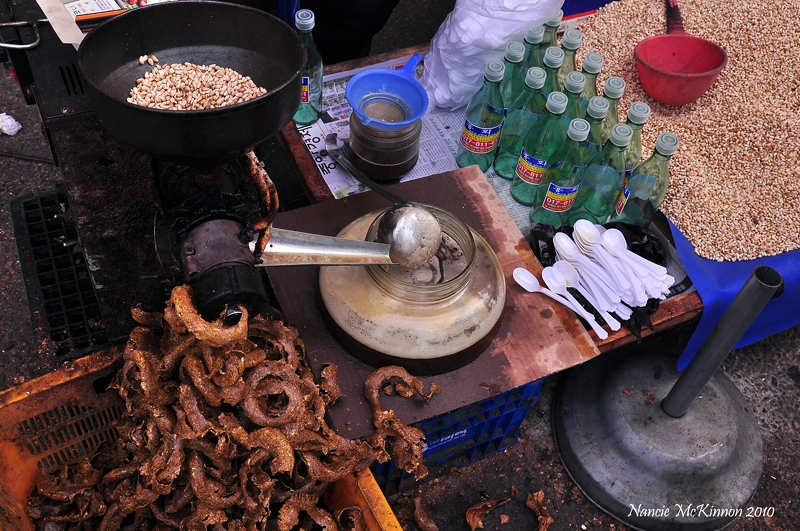
After our brief “pit stop” we were off again, arriving in Yeongju/Seonbichon around 1pm. The first order of business was lunch. The restaurant can best described as something reminiscent of an airplane hangar with dirt floors! Thankfully, the food was delicious.
The rich tofu and vegetable soup was literally bubbling as it arrived at our table. This and a selection of banchan (side dishes) easily put everyone’s hunger at rest.
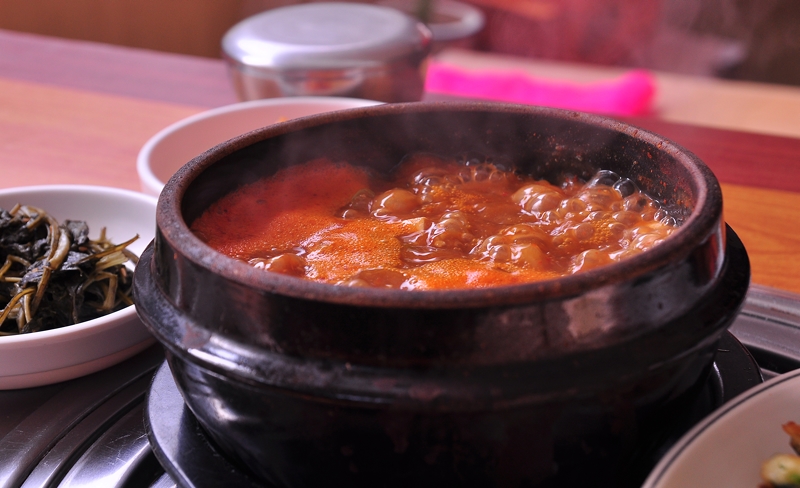
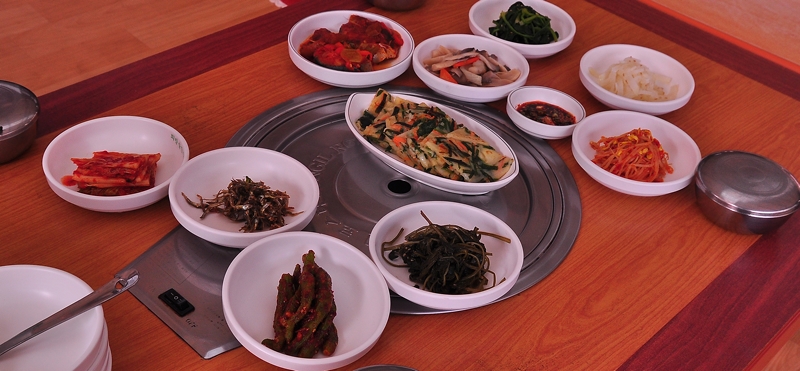
Once our hunger was taken care of it was time to enjoy the Seonbichon village. We were even provided with our own private tour guide for the afternoon. Performers were setting up in the square, and we had 15 minutes to watch before heading into our scheduled tour of the Sosu Museum. Today’s performance was a reenactment of a traditional civil court trial. You can see here that the prisoner didn’t have much respect for his captors!
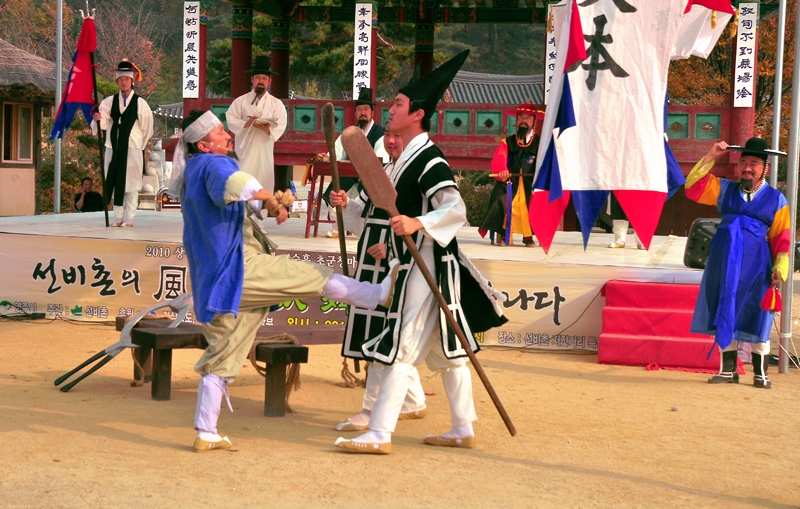
Some of the traditional performers enjoyed having their photos taken, while at least one looked a bit “sour” about being in front of the lens. Don’t you love the head gear? !
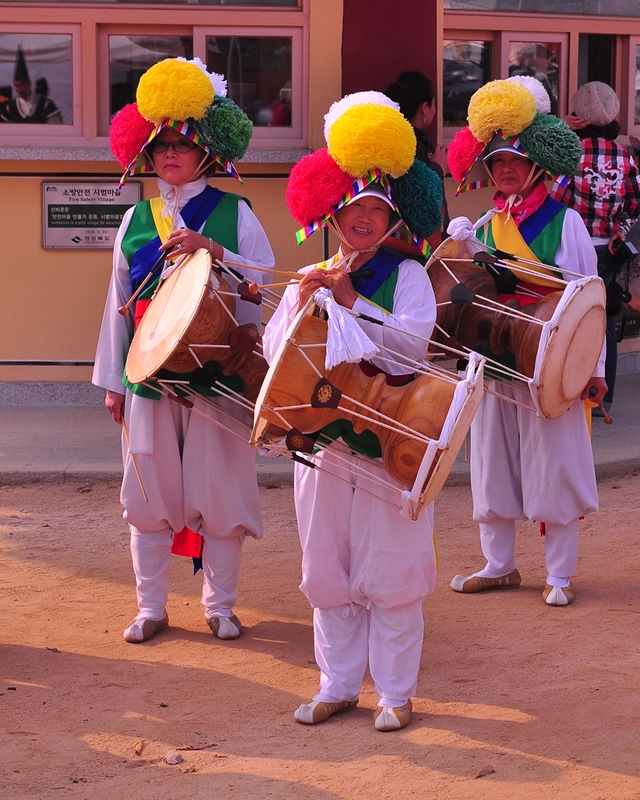
Next it was off for a tour of the Sosu Museum, which was much more crowded that I had anticipated. We were instructed to stay close to the tour guide. The museum is a recent edition and I was impressed with the “English friendly” displays. This was one place where we didn’t need a guide. I would have loved to have wandered around on my own, but that was not to be. That’s okay; gives me a reason to return. Outside again, it was time to tour the traditional village. Here’s a view from the riverbank.
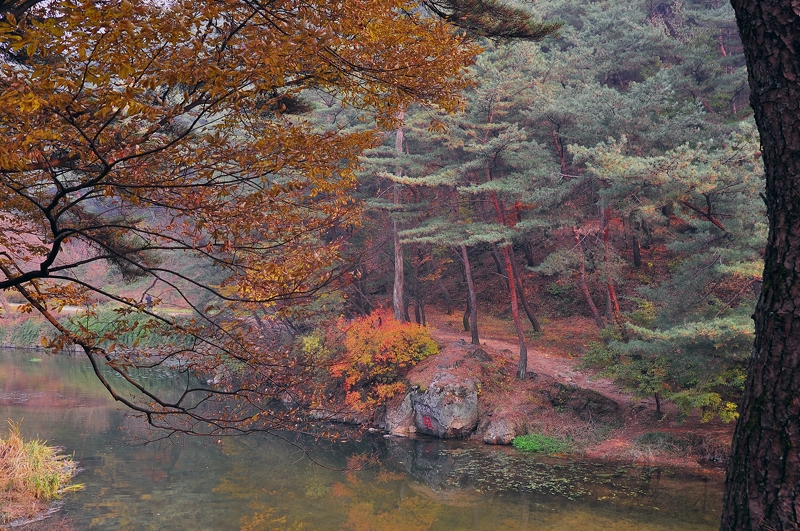
The “villagers” were preparing doek, a traditional rice “sweet”. First the rice has to be pounded with this huge mallet. Imagine the great arm muscles you’d have if you did this every day!
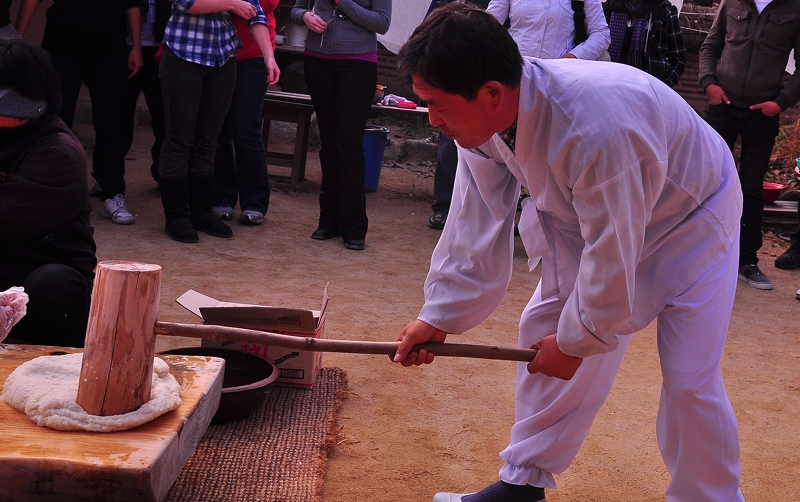
Ready to eat after being dredged in bean powder, and cut into bit size pieces. The bean paste give the doek a bit of a chalky texture with a touch of sweet.
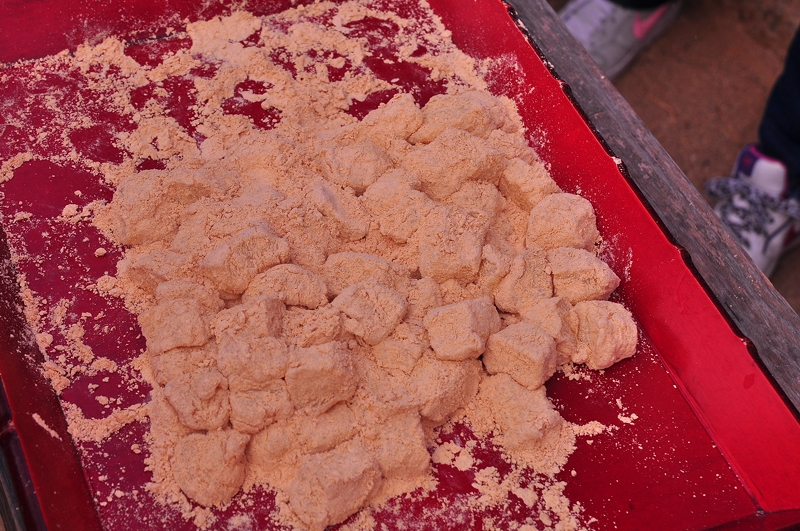
Then it was on to learn some traditional calligraphy. Our instructor was a lovely older gentleman dressed in traditional scholarly garb. After a bit of sign language we figured out that he wanted his photo taken with yours truly.
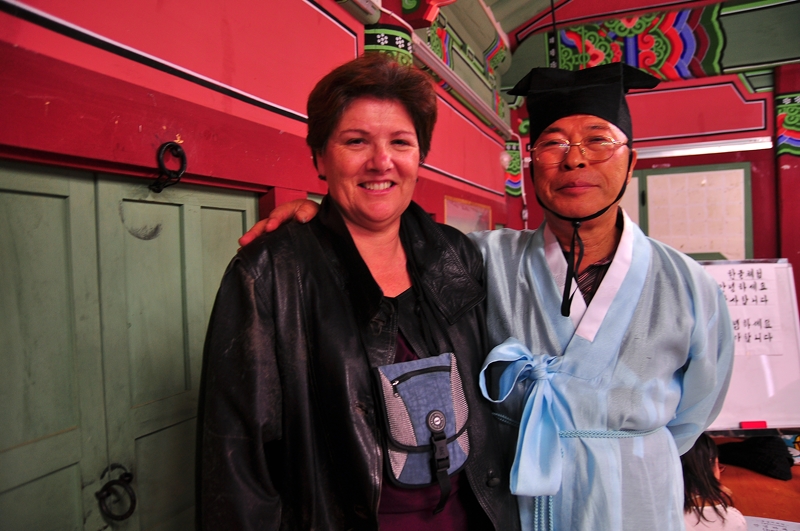
Time to take a few more photos in the village before dinner.
The totems are always found at the entrance to a traditional Korean village.
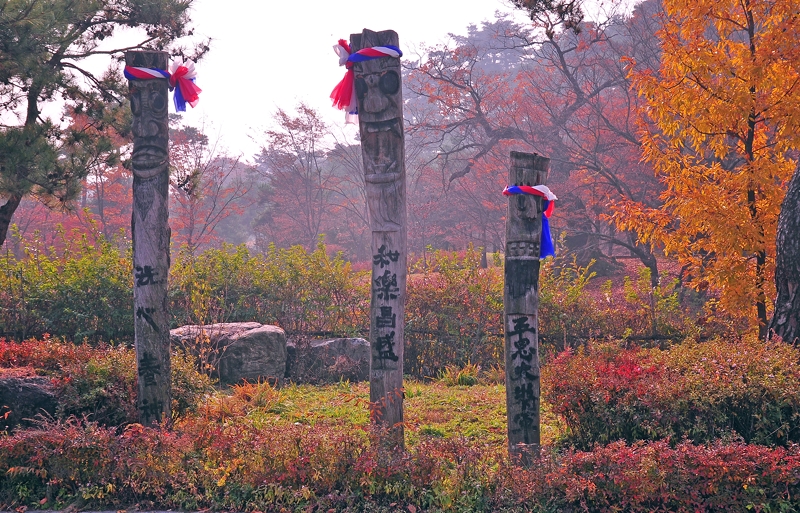
On the way to dinner.
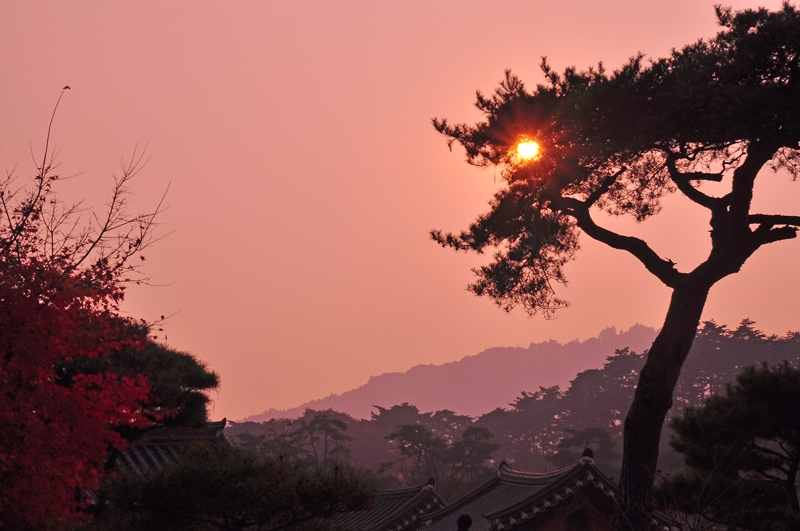
Back to the “airport hangar” restaurant for dinner. Once again the food made up for the lack of ambiance. We were served traditional grilled mackerel with a delicious variety of banchan.
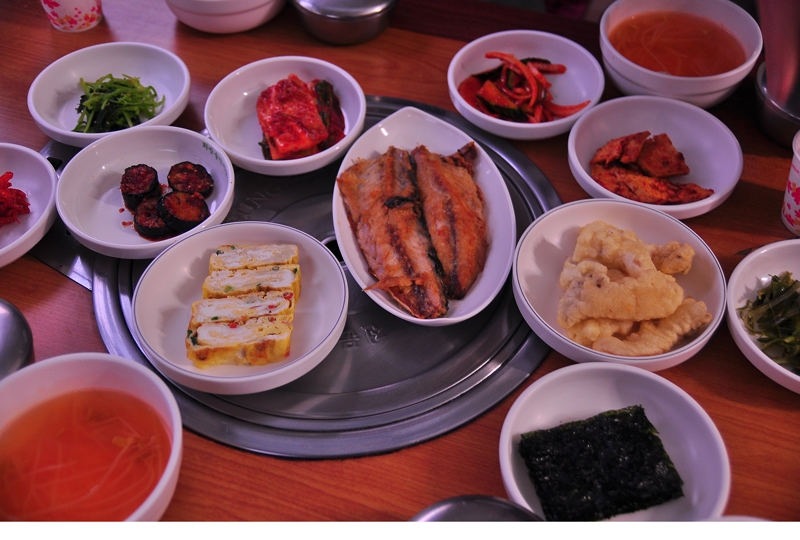
Darkness had descended by the time we had finished our meal, and it was off to Punggi Hotel to settle in for the evening. My single room had a comfortable bed, floor heating and a TV with English channels (YAY). I decided to make it an early night since breakfast was at 7am, to be followed by a visit to the Punggi Ginseng Market. Koreans call ginseng Insam, and it’s extremely popular here for its medicinal properties. I’ll leave you with a photo of fresh ginseng, and more to come in Part 2 of Day Tripping in Rural Korea.
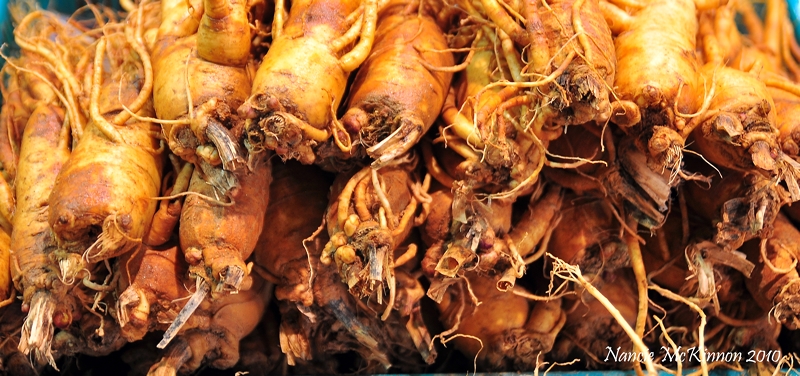
All of the photos are for sale. Click on any of the links above each photo for more information.

15 responses to “Day Tripping in Rural Korea — Part 1”
[…] This post was mentioned on Twitter by Learn Language, Michael Lynch. Michael Lynch said: Day Tripping in Rural Korea | Budget Travelers Sandbox http://su.pr/233PbC This will make you want to visit Korea ! […]
Love the autumn colors in the photos. Makes me want to visit Korea, again, someday. Room for a tent in your garden?
Cheers,
Mike
Can always find a little patch of your tent Mike!
there are not many posts on rural Korea, this is a great post. I love the Korean culture and its strongest or more visible in the rural areas
Hi Zablon………..Compared to other Asian countries Korea is still off the beaten track when it comes to western tourists. Traveling around this past weekend we were pretty much the only westerners (and English speaking.)
What a fantastic post. So much local culture fit in. Can’t wait to hear about Day 2.
Thanks Nicole. Part 2 will be posted soon.
There is something so incredible about rural anything that makes it so photogenic and so compelling. Agreed, “so much local culture to fit in”
I love cities, but usually, for me, it’s outside of the hustle and bustle where I find a country’s “cultural pulse”.
[…] In case you missed it “Day Tripping in Rural Korea, Part 1″……. […]
What a wonderful offer they’ve made with this tour. Thanks for taking us along with this excellent series of images and detailed description.
That photo of the drummers is priceless! The bean paste — which I presume is similar to the Japanese one — takes me back two decades to sweet bean filled rolls at temple fairs in the latter country. I loved them, but my wife hated them!
And finally, let me say that it’s great to see you showing up in that photo!
All the best,
Andrew.
I’m glad you enjoyed the post Andrew.
Not the best photo. My face looks awfully red next to that wall…..haha.
I’m not a real bean paste fan either. However, on this it was good. What I don’t like is when the bean paste is in the middle of a bun and you bite into it. It’s one of the few Korean food that I really dislike.
Excellent article! Well balanced, nicely pictured, interesting information. The picture near the river – very beautiful! And the food looks delicious. Thanks
Hi Aka, Glad you enjoyed the article. It was a fun weekend.
Nancy!! you have a top notch blog here. keep up the good work